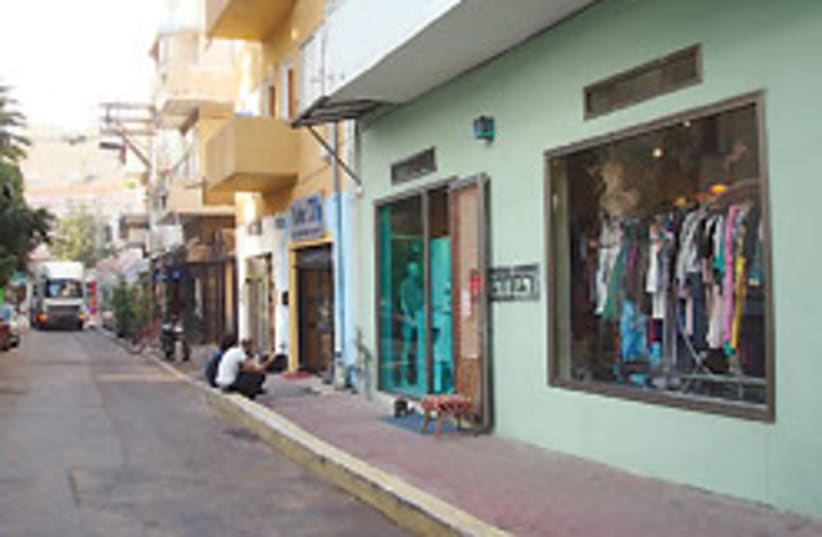Streetwise: Plonit and Almonit alleys
Two Tel Aviv side streets prefer to remain nameless.
 (photo credit: Sari Nossbaum )
You may think twice if an acquaintance asks you to meet them at the underground shop (Hamahteret) on the unidentified alley (Simta Almonit). But contrary to their mysterious titles, Simta Plonit and Simta Almonit are funky and unique alleyways, extending far beyond their names.
Situated in the hip shopping district in downtown Tel Aviv, just off King George Street, these two small "nameless" dead-end alleys start parallel to one another and converge within. They are no longer than 50 meters long, and contain an eclectic group of apartment buildings along with a handful of shops, including a trendy fashion boutique (Hamahteret), an art gallery, a café and a hair salon.
The most prominent feature of Simta Plonit is the architecture of the apartment building at its rear. With a curved structure, shuttered windows and small balconies, it creates a quaint European ambiance with a hint of tranquility - particularly in contrast to the hustle and bustle on the adjacent streets.
Just in front of the building stands a small gold sculpture of a lion, with the blank plaque beneath it corresponding to the ambiguity of the name of the street on which it is situated. While the artist remains anonymous, its supplier, Meir Shapira, was definitely not shy. Shapira, who was a very wealthy businessman from Detroit, was fervently involved in the establishment of the streets in the area when they were being built in 1922.
He purchased the sculpture as a gesture to his wife, Sonya, and then used his status and money to name the two alleyways after him and his wife respectively, without consulting the city council.
But Shapira wasn't the only Meir with power. Through his supposedly shrewd endeavor, Shapira got himself entangled in a heated clash with Meir Dizengoff, who wasn't just another Meir, but the mayor of Tel Aviv. Dizengoff was appalled by Shapira's audacity, and refused to allow the designation of the streets to remain as Shapira had intended.
After an intense back-and-forward squabble, Dizengoff resolved to exhibit his power and deliberately named the alleyways Plonit and Almonit (anonymous or nameless), just so that Shapira would not have the satisfaction of having any memory left of himself or his wife after their deaths.
While Dizengoff may have succeeded in keeping the alleyways "nameless," they have certainly managed to forge an identity of their own.
if(catID != 151){
var cont = `Take Israel home with the new
Jerusalem Post Store
(photo credit: Sari Nossbaum )
You may think twice if an acquaintance asks you to meet them at the underground shop (Hamahteret) on the unidentified alley (Simta Almonit). But contrary to their mysterious titles, Simta Plonit and Simta Almonit are funky and unique alleyways, extending far beyond their names.
Situated in the hip shopping district in downtown Tel Aviv, just off King George Street, these two small "nameless" dead-end alleys start parallel to one another and converge within. They are no longer than 50 meters long, and contain an eclectic group of apartment buildings along with a handful of shops, including a trendy fashion boutique (Hamahteret), an art gallery, a café and a hair salon.
The most prominent feature of Simta Plonit is the architecture of the apartment building at its rear. With a curved structure, shuttered windows and small balconies, it creates a quaint European ambiance with a hint of tranquility - particularly in contrast to the hustle and bustle on the adjacent streets.
Just in front of the building stands a small gold sculpture of a lion, with the blank plaque beneath it corresponding to the ambiguity of the name of the street on which it is situated. While the artist remains anonymous, its supplier, Meir Shapira, was definitely not shy. Shapira, who was a very wealthy businessman from Detroit, was fervently involved in the establishment of the streets in the area when they were being built in 1922.
He purchased the sculpture as a gesture to his wife, Sonya, and then used his status and money to name the two alleyways after him and his wife respectively, without consulting the city council.
But Shapira wasn't the only Meir with power. Through his supposedly shrewd endeavor, Shapira got himself entangled in a heated clash with Meir Dizengoff, who wasn't just another Meir, but the mayor of Tel Aviv. Dizengoff was appalled by Shapira's audacity, and refused to allow the designation of the streets to remain as Shapira had intended.
After an intense back-and-forward squabble, Dizengoff resolved to exhibit his power and deliberately named the alleyways Plonit and Almonit (anonymous or nameless), just so that Shapira would not have the satisfaction of having any memory left of himself or his wife after their deaths.
While Dizengoff may have succeeded in keeping the alleyways "nameless," they have certainly managed to forge an identity of their own.
if(catID != 151){
var cont = `Take Israel home with the new
Jerusalem Post Store
Shop now >>
`;
document.getElementById("linkPremium").innerHTML = cont;
var divWithLink = document.getElementById("premium-link");
if(divWithLink !== null && divWithLink !== 'undefined')
{
divWithLink.style.border = "solid 1px #cb0f3e";
divWithLink.style.textAlign = "center";
divWithLink.style.marginBottom = "40px";
divWithLink.style.marginTop = "40px";
divWithLink.style.width = "728px";
divWithLink.style.backgroundColor = "#3c4860";
divWithLink.style.color = "#ffffff";
}
}
(function (v, i){
});

